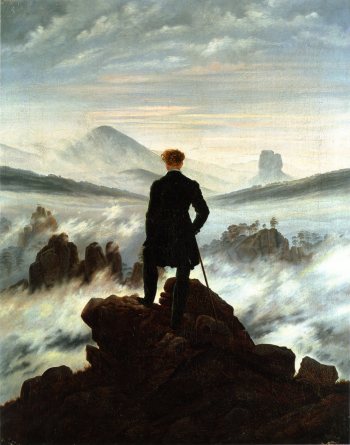No edit summary |
No edit summary |
||
| Line 3: | Line 3: | ||
''Der Wanderer über dem Nebelmeer'' (Wanderer Above the Mist) by Caspar David Friedrich, 1818. Cover image from the 1902 English-language edition of Goethe's ''The Sorrows of Young Werther'', translated by R.D. Boylan, Edited by Nathen Haskell Dole | ''Der Wanderer über dem Nebelmeer'' (Wanderer Above the Mist) by Caspar David Friedrich, 1818. Cover image from the 1902 English-language edition of Goethe's ''The Sorrows of Young Werther'', translated by R.D. Boylan, Edited by Nathen Haskell Dole | ||
My work, an untitled collection of objects, looks to explore ideas surrounding cultural and historical value. I | My work, an untitled collection of objects, looks to explore ideas surrounding cultural and historical value. I'm interested in objects and other forms of representation that appropriate cultural value as simply another material: | ||
The construction of identity, place, politics and economy are naturally implicated, as are references to museology, the Romantic and Classical periods, and contemporary art practice. | |||
The collection takes form as a series of small objects made from plaster-of-Paris, paper, wax, and voice recordings (audible through headphones). The objects include a number of miniature masks taken from statuettes of canonical German cultural figures, as well as traces of other common items and an image-based exploration of representations of exotic wildlife from the GDR. | |||
At once these objects are particularly significant to central Germany because of the cummulative dialogue they foster, and yet they remain poignant more widely as part of an ongoing negotiation with the dynamics of culture and history and our relationship to | At once these objects are particularly significant to central Germany because of the cummulative dialogue they foster, and yet they remain poignant more widely as part of an ongoing negotiation with the dynamics of culture and history and our relationship to them. The collection does not seek to fabricate or foster a narrative, instead remaining honest to the abject sense of irony it puts forward. | ||
Revision as of 16:29, 28 January 2013
Der Wanderer über dem Nebelmeer (Wanderer Above the Mist) by Caspar David Friedrich, 1818. Cover image from the 1902 English-language edition of Goethe's The Sorrows of Young Werther, translated by R.D. Boylan, Edited by Nathen Haskell Dole
My work, an untitled collection of objects, looks to explore ideas surrounding cultural and historical value. I'm interested in objects and other forms of representation that appropriate cultural value as simply another material: The construction of identity, place, politics and economy are naturally implicated, as are references to museology, the Romantic and Classical periods, and contemporary art practice.
The collection takes form as a series of small objects made from plaster-of-Paris, paper, wax, and voice recordings (audible through headphones). The objects include a number of miniature masks taken from statuettes of canonical German cultural figures, as well as traces of other common items and an image-based exploration of representations of exotic wildlife from the GDR.
At once these objects are particularly significant to central Germany because of the cummulative dialogue they foster, and yet they remain poignant more widely as part of an ongoing negotiation with the dynamics of culture and history and our relationship to them. The collection does not seek to fabricate or foster a narrative, instead remaining honest to the abject sense of irony it puts forward.
